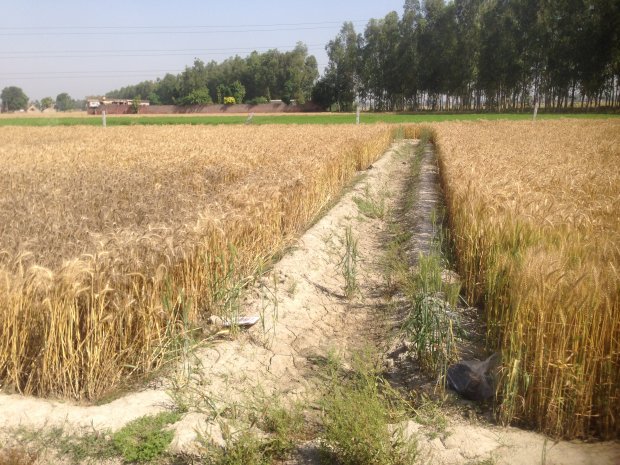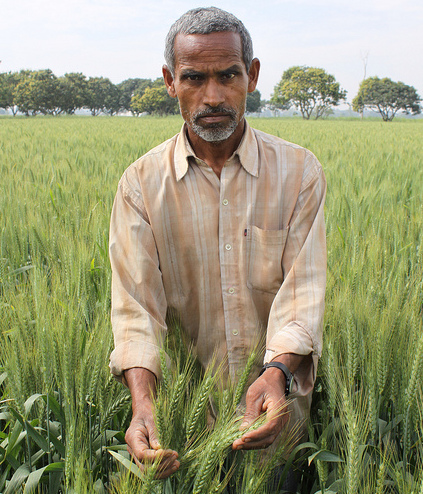
Julianna White is program manager for low emissions agriculture at the CGIAR Research Program on Climate Change, Agriculture and Food Security. Tek Sapkota is a scientist with the International Maize and Wheat Improvment Center and lead author of the study. Any opinions expressed are their own.
Research shows conservation agriculture increases the income of farmers, moderates canopy temperatures, improves irrigation productivity and reduces greenhouse gas emissions in cereal systems in the Indo-Gangetic plains.
Conservation agriculture practices are also climate-smart, meaning they help farmers adapt to climate change while minimizing greenhouse gas emissions, found researchers from CIMMYT, the Borlaug Institute for South Asia and the CGIAR Research Program on Climate Change, Agriculture and Food Security (CCAFS).
In an August 2015 article in the Journal of Integrative Agriculture, researchers report that a comprehensive literature review and evidence collected from on-farm trials showed that conservation agriculture – defined as minimal soil disturbance and permanent soil cover combined with appropriate rotations – improved farmers’ income, helped crops sustain or adapt to heat and water stresses, and reduced agriculture’s contribution to greenhouse gas emissions in cereal systems in South Asia.

Farmers reap economic benefits
Conservation agriculture recommends minimal soil disturbance, most commonly tillage. Farmers who practiced zero tillage saved 23 percent in production costs by avoiding preparatory tillage and reducing the number of times fields were irrigated, while reaping the same or slightly higher yields.
Minimizing heat stress
High temperatures during the maturity stage cause wheat to decrease grain size, lowering overall yields, a phenomenon known as “terminal heat effect.” Farmers who practice conservation agriculture avoid this heat stress because residues left on the surface of the field conserve soil moisture, enhancing transpiration and creating a cooling effect – thus avoiding reduced yields caused by terminal heat effect.
Efficient use of water resources
Researchers found multiple examples that the zero tillage component of conservation agriculture led to significant water savings in both rice and wheat systems. Water savings accrued across systems. In rice-wheat systems, retention of wheat residues reduces water use in rice, and retention of rice residues causes reduced water use in wheat. Non-requirement of preparatory tillage advances the planting times thereby increasing rainwater-use efficiency and utilizing residual moisture from the previous crop.
Decrease in greenhouse gas emissions
Minimizing soil disturbance allows for soil carbon to accumulate, causing a net soil carbon gain. Although scientists are still debating the extent of soil carbon sequestered through conservation agriculture, indirect emissions reductions are numerous: less power and fuel consumption due to decreased tillage in conservation agriculture, decreased labor from machines and humans, and slower depreciation of equipment.
Business-as-usual production practices such as conventional tillage and farmers’ nutrient and irrigation management systems are greenhouse gas-intensive, while zero tillage reduces energy consumption in land preparation and crop establishment and efficient use of water resources reduces energy needs from pumping. Leaving residues in the field increases soil health and fertility, thereby reducing the need for chemical fertilizers.
Researchers found that, on average, farmers could save 36 liters of diesel per hectare, equivalent to a reduction in 93 kg CO2 emission per hectare per year by practicing zero tillage for land preparation and crop establishment in the rice-wheat system typical on the Indo-Gangetic Plain. Given that 13.5 million hectares are under rice-wheat system cultivation in the region, this represents a reduction of 12.6 megatons of CO2 equivalent.
New technologies increase uptake of conservation agriculture
Despite excellent productivity, economic gains and environmental benefits, adoption of conservation agriculture in South Asia is still relatively slow, most likely due to various technological and socio-economic factors. It takes years and ample evidence for farmers to change the entrenched habit of tillage with planting. And it is a process.
For example, some farmers have adopted zero-tillage in wheat production, primarily to facilitate early planting, lower production costs and increase yields (and therefore profitabilitiy). However, these same farmers still prefer to practice tillage and puddling (wet-tillage) in their rice crops for weed control and reduction in percolation loss of water/nutrient. Also, farmers tend to burn crop residues to facilitate planting with the zero-tillage drill. To realize the full potential of conservation agriculture, all crops in rotation have to be brought under zero tillage, and crop residues will have to be used as soil surface mulch.
Due to the recent development of the “Turbo Happy Seeder,” which can drill seed and fertilizer directly through loose and anchored crop residues, farmers are gradually moving towards zero tillage across the agriculture system.
Farmers who practice conservation agriculture also must adjust their nutrient management systems in order to maximize crop productivity decrease costs. Conventional fertilizer recommendations have been calibrated based on tillage-based systems are thus not necessarily appropriate for conservation agriculture systems, including nutrient stewardship (applying the right source of fertilizer at the right time in right place using right method).
Crop residue management is essential for continuous coil cover, an important component of conservation agriculture, but farmers are faced with competing uses of crop residue as livestock feed, fuel, mulch and compost. Local adaptive research is needed to address strategic residue and nutrient management, weed control and scale-appropriate machinery development.
Such a paradigm shift in crop management requires a mindset transition among farmers and other value chain actors, including researchers, extension agents, market players and other institutions. Though it is recognized that transition takes time, recent progress and development in weed control and nutrient management systems signal that practice of conservation agriculture is growing across the region, including among different socio-economic groups and farm typologies.
CCAFS and CIMMYT continue research and implementation of low emissions agriculture across the globe. See also the regional focus on conservation and climate-smart agriculture in South Asia.
 Climate adaptation and mitigation
Climate adaptation and mitigation 
